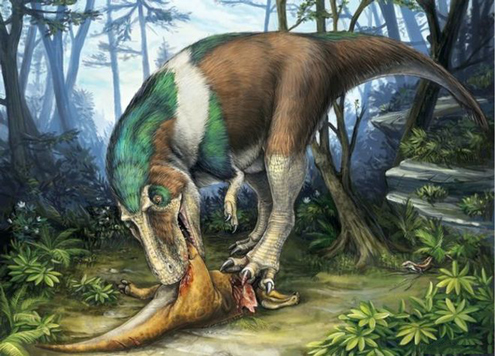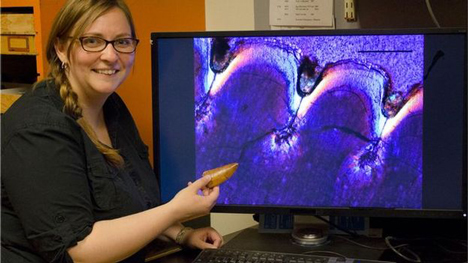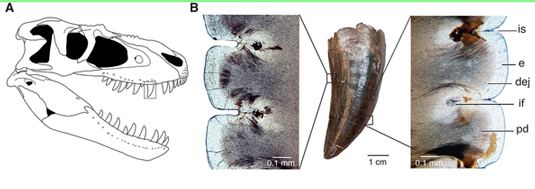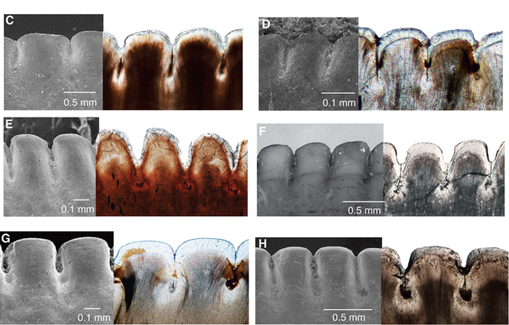Structural Secrets of Theropod Teeth
Theropod dinosaurs, the majority of which were carnivorous, had a distinct advantage over other Mesozoic predators. Their teeth had a deeply folded, serrated tooth structure that allowed them to rip and tear into the bodies of their victims. This crucial, layered structure to the teeth has been identified by researchers from the University of Toronto Mississauga, with the assistance of colleagues from Taiwan and published today in the academic journal “Scientific Reports.”
A Specialised Tooth Structure for Feeding on Large Prey
Picture credit: Daniele Dufault
The picture above shows a feathered Gorgosaurus, a member of the Tyrannosauridae family, feeding on a young Corythosaurus.
Theropod Teeth
The research team used scanning electron microscopes and a synchrotron located in Taiwan to study a wide variety of theropod teeth from the collections of Canadian museums, including the Royal Tyrrell, and the Royal Ontario Museum. Meat-eating dinosaurs in the study, included Gorgosaurus, the Triassic predator Coelophysis, Tyrannosaurus rex, Allosaurus, and the giant African theropod Carcharodontosaurus. Other non-Dinosauria creatures involved in the teeth study were Smilodon spp. and the shark O. megalodon, as well as early archosaurs, as the scientists tried to identify the evolutionary origins of these rather unique inter-dental folds.
Extant animals were also included in the research. The only living animals with similar dentition and internal teeth structures are the Monitor Lizards, most notably the formidable Komodo dragon (Varanus komodoensis). It is the largest lizard alive today and specialises in hunting large animals, thus reinforcing the theory put forward by the Canadian research team that these inter-dental folds evolved specifically to assist with predation of large herbivores.
Hidden Complexity of Dinosaur Teeth
Dr Kirstin Brink, a post-doctoral researcher in the Department of Biology, one of the authors of the paper commented:
“What is so fascinating to me is that all animal teeth are made from the same building blocks, but the way the blocks fit together to form the structure of the tooth greatly affects how that animal processes food. The hidden complexity of the tooth structure in theropods suggests that they were more efficient at handling prey than previously thought, likely contributing to their success.”
Dr Kristin Brink with one of the Theropod Teeth Examines the Evidence
Picture credit: University of Toronto Mississauga
The picture above shows Dr Brink examining the special arrangement of layers of dentine at the base of the each tooth serration (denticle). She is holding a tooth from the giant theropod Carcharodontosaurus.
Dinosaur Bite Forces
A lot of research has been undertaken into the bite forces of extinct animals, but this is the first time a study of this type has been carried out. The teeth may have an outer coating of enamel, just like our teeth, but the tough dentine inside has a unique configuration of dental folds and this gives the teeth of theropod dinosaurs enlarged serrations, ideal for tearing into flesh.
The shape of the teeth (morphology) and their development, both in terms of their evolution and how they develop in an individual. can provide palaeontologists with a lot of information on the evolution of extinct animals and provide insights into feeding behaviour.
Theropod teeth, the only group of the Order Dinosauria, known to have produced meat-eaters, are characterised by the presence of serrations, known as denticles on the cutting edges of their teeth. These serrations vary between genera, with troodontids for example, having relatively large denticles, whilst spinosaurids have proportionately much smaller ones.
Ziphodont Teeth
Teeth that are serrated along the cutting edge are referred to as ziphodont teeth. In a study, Everything Dinosaur reported upon last year, the same University research team, examined the ziphodont teeth of Dimetrodon (D. grandis). They concluded that the serrations gave this pelycosaur an evolutionary advantage over other Permian predators.
To read more about this study: Dimetrodon with Teeth Like a Steak Knife.
In this new paper, the researchers conclude that the structures previously thought to prevent tooth breakage, instead, first evolved to shape and maintain the characteristic denticles throughout the life of the tooth. The relatively novel and complex dental folds produced at the base of the teeth characterises the theropods, with the exception of those genera that evolved a modified diet and a less meat intensive diet. The scientists conclude that these teeth structures are vital for allowing the predation and consumption of large prey animals.
A Close up of a Gorgosaurus Tooth (Royal Ontario Museum Collection)
Picture credit: Scientific Reports
Examing the Skull and Teeth of Gorgosaurus
The picture above shows an illustration of the skull of the tyrannosaurid Gorgosaurus (A), drawing by Danielle Dufault. The complete tooth (ROM 57981) is shown in (B) with extreme close ups of the denticles on the cutting edges of the tooth. The tooth illustrated is from the upper jaw (maxilla).
Key
- dej = dentine/enamel junction
- e = enamel (outer coating of the tooth)
- if = inter-dental fold
- is = inter-dental sulcus
- pd = primary dentine
The Sharp Edges of Predators Teeth Viewed Under Scanning Electron Microscopy
Picture credit: Scientific Reports
Theropod Teeth Up Close
The cutting edges (carinae) of various predators (all are examples of ziphodont teeth). Pictures are from scanning electron microscopy images. Note the scale bars and the pictures to the right of the black and white images are thin cross sections showing internal structure.
Key
- C = unknown phytosaur
- D = Coelophysis bauri
- E = Allosaurus fragilis
- F = Carcharodontosaurus saharicus
- G = Gorgosaurus libratus
- H = Tyrannosaurus rex
This adaptation may have played an important part in the initial radiation and subsequent success of the Theropoda as terrestrial apex predators. After all, the theropod body shape and bauplan, especially those teeth, permitted them to dominate terrestrial ecosystems for the best part of 160 million years.









